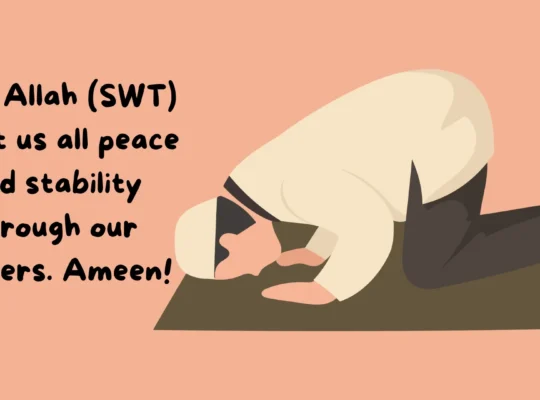The Physical Strength of Prophet Muhammad (PBUH)
Prophet Muhammad (ﷺ) is widely revered for his character, wisdom, and leadership. However, an often-overlooked aspect of his personality is his remarkable physical strength and endurance. Physical strength of Prophet Muhammad (PBUH) was not just in terms of physical might but also in resilience, discipline, and overall fitness. In today’s world, where fitness is a growing concern, we can draw valuable lessons from his life to improve our health and well-being.

1. Stamina and Physical Strength of Prophet Muhammad (PBUH)
a) Strength in Battle
Prophet Muhammad (ﷺ) was known for his physical prowess, especially in times of battle. He participated in numerous battles, including Badr, Uhud, and Khandaq, where his stamina and physical abilities were evident. His companions reported that he fought with incredible courage and skill, often being at the forefront of the battlefield. His ability to wield heavy weapons, engage in combat, and endure long hours in harsh conditions reflected his superior strength.
b) Wrestling and Personal Strength
One of the most well-known instances of his strength was his wrestling match with Rukanah, a famous wrestler of Makkah. Rukanah was known for his unmatched strength, but Prophet Muhammad (ﷺ) defeated him multiple times, demonstrating his physical ability and agility. This incident highlights not only his muscular strength but also his knowledge of body mechanics and movement.
c) Endurance in Daily Life
Apart from battles and wrestling, Prophet Muhammad (ﷺ) displayed exceptional stamina in his daily life. He would walk long distances, fast regularly, and engage in physically demanding activities such as digging trenches during the Battle of Khandaq. His active lifestyle kept him in peak physical condition, setting an example for his followers.
2. Lessons for Modern Fitness
The Prophet’s (ﷺ) life offers timeless lessons for modern fitness enthusiasts. His lifestyle was a balanced mix of physical activity, diet, and mental well-being. Here’s how we can incorporate these lessons into our daily lives:
a) Regular Physical Activity
Prophet Muhammad (ﷺ) encouraged physical activity as part of a healthy lifestyle. He engaged in walking, running, archery, and horseback riding. These activities not only built strength but also improved cardiovascular health and endurance.
Modern Application:
- Walking and Running: Make walking a daily habit. Running or jogging can also be an excellent way to improve heart health.
- Strength Training: Incorporate bodyweight exercises like push-ups, squats, and planks to build core strength.
- Sports and Outdoor Activities: Engaging in sports like swimming, cycling, or martial arts can improve overall fitness.
b) The Role of Fasting in Fitness
Fasting was a significant part of the Prophet’s (ﷺ) life. He would fast on Mondays and Thursdays and observed intermittent fasting through the Sunnah of fasting the white days (13th, 14th, and 15th of every lunar month).
Modern Application:
- Intermittent Fasting: Research supports the benefits of fasting for fat loss, muscle preservation, and overall health.
- Improved Digestion: Fasting allows the body to detoxify and reset, promoting better digestion and metabolic function.
- Increased Discipline: Fasting instills self-control and discipline, making it easier to stick to a healthy diet.
c) Natural and Wholesome Diet
The Prophet (ﷺ) followed a natural, balanced diet consisting of dates, honey, barley, milk, and lean meat. He discouraged overeating and promoted moderation in food consumption.
Modern Application:
- Eat Whole Foods: Focus on unprocessed, natural foods such as fruits, vegetables, whole grains, and lean proteins.
- Portion Control: Avoid overeating and follow the Sunnah of eating in moderation.
d) Mental and Spiritual Fitness
Physical strength is not just about muscles; it is also about mental and spiritual resilience. Prophet Muhammad (ﷺ) engaged in deep spiritual practices, including prayer, meditation (dhikr), and reflection.
Modern Application:
- Mindfulness and Stress Reduction: Engage in meditation, deep breathing, and prayer to reduce stress.
- Good Sleep Habits: Follow a consistent sleep schedule to allow the body to recover.
- Positive Thinking: Maintain a positive outlook on life, as mental strength is key to physical fitness.
Physical Strength of Prophet Muhammad (PBUH) & Practical Fitness Routine for Fitness
Here is a simple fitness routine to follow:
Morning Routine:
- Start the day with Fajr prayer and stretching exercises.
- Go for a brisk walk or light jog.
Midday Routine:
- Engage in strength training exercises like push-ups, squats, and lunges.
- Have a nutritious meal with dates, fruits, and lean proteins.
Evening Routine:
- Engage in an outdoor activity such as swimming, cycling, or walking.
- Reflect and engage in mindfulness exercises before sleeping.
Physical Strength of Prophet Muhammad (PBUH)
Physical strength of prophet Muhammad (PBUH) was a combination of disciplined lifestyle choices and strong mental resilience. In today’s fast-paced world, his habits provide a perfect blueprint for achieving optimal health and fitness. By incorporating his principles into our lives, we can improve our physical well-being while maintaining spiritual and mental balance.
The key takeaway from his life is that fitness is not just about looking strong but also about developing endurance, discipline, and a holistic approach to well-being. May we all strive to follow his exemplary lifestyle for a healthier and more fulfilling life.
Read: How Daily Salah (Prayer) Promotes Mental Peace and Stability








[…] The Physical Strength of Prophet Muhammad (ﷺ) […]